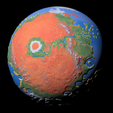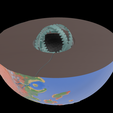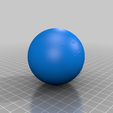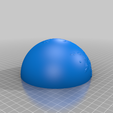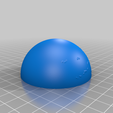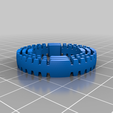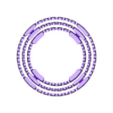Originally published here on Thingiverse (https://www.thingiverse.com/thing:4773238).
This is my interpretation of the Red Moon where it takes place Manifold: Origin, a hard science fiction novel full of gore, by Stephen Baxter. It has nothing to do with the real Earth's Moon (https://www.thingiverse.com/thing:3419235) [1]; in the book, it is a planetoid, a bit bigger than Mars (https://www.thingiverse.com/thing:3513228), that suddenly appeared in the same place and orbit of the real counterpart, replacing it, and causing disasters on Earth (https://www.thingiverse.com/thing:3612782) after its huge tidal force. This post will be full of spoilers, so if you are planning to read the book, read it first.
I made this model using Ubuntu available tools, not because of having any advantage, but because I was forced to work on Linux at that time, so I challenged to myself to learn to use free-soft tools with this model. I used GIMP instead of Paint.net for drawing the topography; Octave instead of MATLAB for plotting the 3D model; MeshLab for simplifying the meshes, instead of Microsoft 3D Builder; Freecad [2] instead of SolidWorks for the tunnel and the World Engine; and Blender for subtracting the tunnel and the chamber, and painting the outer surface, instead of 3D Builder or Paint 3D.
Characteristics taken from the book
I took as much information as I could from the book, though I had to leave out some concepts that contradicts other, but the small details I had to make them up, as they are not as much detailed. I will list some of the features taken into account:
- Its visible disc has five times as surface as Luna [3].
- It has one big continent mostly rounded as if the moon's center of mass was displaced from the geometric center.
- There is a huge volcano at the center of the continent, nicknamed "Bullseye", surrounded by glaciers, and then, by vegetation. I made it twice as big as the real Olympus Mons.
- From the Bullseye it is born a Nile like river that ends on the east coast.
- The inland of the supercontinent is a rusted red, Mars like, dessert, with giant eroded craters. The vegetation is restricted to the coastlines. Two mountain beltways run along the east and west coasts.
- There is a spherical chamber in the "very heart" of the moon. I made it displaced from the geometric center so that it can explain the displacement of the center of mass.
- The chamber has something "blocky, obviously artificial," lurking within, that is the "World Engine". It is implied that this is huge but it does not occupy the whole chamber, but since the biggest scale I have made is something 13 cm in diameter, the space for something in the chamber is small (4 cm), so I decided to do like it is shown in one of the images. There is not a well detailed description of the engine in the book, so I made up a gyroscope-like stylised structure.
- It is said that the entrance of the tunnel that leads to the chamber is placed in a small crater in the East coast, and that this crater is "diametrically opposite" to the Bullseye; however, this is not possible taking into account all the previous constrains, so I intentionally ignore this one.
Inhabitants of the Red Moon
From this point on, everything is a spoiler, so you are already warned. Many of the races listed behind are based on extinct pre-human species; they are not time-travelled hominines, but morphologically similar descendant of them, so they cannot be treated as the real species they are meant to be.
- Runner folk. Homo erectus [4]. They are tall and thin, dark skinned, primitive face traits but recognisable as humans. They lore in groups of many, nomads, and they develops specific roles for each individual, making tools, starting fire, treating injuries, etc. When they have to do a group task they do it without any synchronisation, chaotically. They speak a few weakly connected English words.
- Elf folk. Australopithecus sp. [4]. Short, dark furred like a chimp but standing strait when walking. Speculative pointing ears and a oddly human face. They are an aggressive folk, gregarious, tree dwelling, and they lack any fluid communication.
- Nutcrackers. Another australopithecine [5] species. Herbivorous, with a big belly and a tall sagital crest, similar to that of gorillas. The author was likely referring to the genus Paranthropus, which is not widely agreed to be a separated genus, and are dubbed as "robust australopithecines".
- Hams. Homo neanderthalensis. They are stocky, heavy built, with pronounced eyebrows and short chin. They speak in a rough English, lacking verbal times, like the typical cartoonish cavemen speak. They are named after biblical characters, and they said to came from a place they call the "Gray Earth"
- English men. Homo sapiens. They are a few, old, male, Victorian Era English astronauts. They live in small towns and use other folks as servants.
- Zealots. Homo sapiens. An ultra religious, Medieval Age civilisation (or just a town?). They use Hams as slaves, Runners as load animals, and they hunt australopithecines [5] as food. It's not clear enough if all of them or just their leader have a tail.
- Daemons. They are 3 m tall, knuckle walkers, fast moving, sapien australopithecines [5], that evolved on an high O2 atmosphere. They are far more advanced than humans, and they developed magic-like technology called Mapping, that allows them to summon things and teleportation. They are not meant to represent any real animal, but it's possible that Baxter was winking at the problematic genus Meganthropus, though bigger.
- Other species include: cats (presumably big felids), hyenas, bats, hunting ground birds (possibly phorusrhacids), deers, mouse deers, duikers, crocodyles, fish, glass shrimps, and an speculative aquatic hominid. The plants mentioned in the book are conifers, grass, brushes, pitcher plants, cloudberry plants and bananas.
Notes
- Probably inspired by the Blood Moon Prophecy
- A pain in the ... back.
- The circular visible disk corresponding to a distant point of view: S = π r^2
- Homo erectus and some species of Australopithecus are most likelly to be chronospecies, that is, species that did not stand firmly on a separate clade, but some population of it, evolved into a new one; in this case, in more modern humans. So that, even late surviving individuals should not be considered the same species.
- "Australopithecines" refers to the sub-tribe Australopithecina, which cladistically includes humans; but in the book, the term is used in a paraphyletic way, including Australopithecus grade hominids, but not the genus Homo.
References

/https://fbi.cults3d.com/uploaders/15008782/illustration-file/d6c9de13-7ac7-4d44-812e-9ee1f2063cd6/red-moon2.png)
